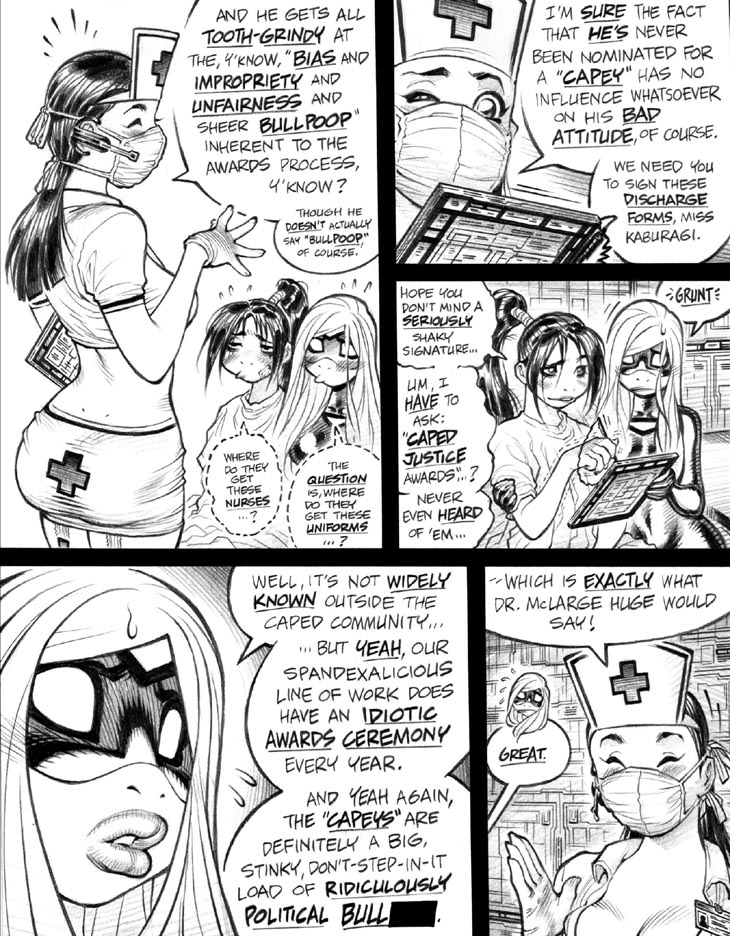This page, alas, is a good example of a problematic Empowered storytelling trend that became noticeable during vol. 4: namely, the dread specter (or spectre, an Anglicization that I must admit I prefer) of excessive dialogue, or “overdialoguing” as I’ve dubbed it.
See, a theoretically good thing about this volume is that it was the first Empowered installment to feature a single storyline running through the book, albeit with occasional tangential interludes; that really is quite a change from the much more random, freewheeling, “throw everything against the narrative wall and see what works” approach of the first three volumes.
However.
The problem with a more cohesive, longer-term storyline running throughout a given volume is that it tends to require quite a bit more set-up and, alas, expository “bricklaying.” (Or so I apparently saw it at the time.) This meant that 2008-Era Me often felt that I had to cram in more dialogue into a given page to properly sow narrative seeds that would bloom later in the book. Tie that issue into my penchant for writing dialogue that amuses me—though not always certain readers!— and lo, we have a recipe for way too many word balloons and too much text on a given page, such as this one. As I’ll be ranting at greater length later, a writer can almost always—as in, always—get away with using less expository set-up that he or she might think.
The tension here, though, is that Empowered actually is a dialogue-based series, for the most part. A good chunk of the earlier stories—especially with scenes set in Emp’s apartment—are, in effect, “situational comedy” driven by dialogue. The problem arose, alas, when I began overloading pages with narrative bricklaying while simultaneously indulging my love for wacky banter and often goofy wordplay. Nowadays, I am much more wary about overdialoguing any given page, as too many word balloons per page becomes, I believe, an obstacle for the reader; God knows, too much dialogue is certainly offputting for me as a reader of comics.
So, brace yourselves for an a new commentary trend that will be running through this volume—and the next few after that, as well. This trend, which I’m sure will come to annoy many of you almost as much as my earlier, incessant mentions of the Mysteriously Intermittent Post-Millennial Torso Glitch, is that I will be often critiquing my younger self for specific, panel-by-panel examples of excessive dialogue.
However (again).
While excessive dialogue is a very real problem in my own comics—and American comics as a whole—I beg of y’all not to bring up the one hackneyed, overused, and invariably misunderstood maxim incessantly deployed in criticism of overdialogued comics: “Show, don’t tell.” I’ll address this topic in numbing detail later, but let me assure you, “show don’t tell” does not, in fact, mean “don’t write dialogue.”
Anyhoo. So, let’s begin the criticism of excess dialogue!
Panel 1: A minor criticism, but to cut back on the dialogue square footage—okay, “inch-age”—on this page, some of the so-called “aside lettering” might’ve been droppable. Here, I mean the Übernurse’s brief clarification about about “bullpoop.” A cute enough bit, but on a comic page that may actually be 50% word balloon by volume, I needed to trim the verbiage wherever possible.
Panel 3: Ninjette’s line about her shaky signature doesn’t add much value to this panel; just the visual of her trembling hand would’ve sufficed to get the point across, as we already mentioned said shakiness on the previous page. One might consider this a rare example of “no need to tell, because you already showed.”
Panel
4: To reduce the verbiage, Emp’s third balloon should’ve been cut down
to something shorter and more to the point, such as, “And, yeah, the
Capeys are bulls**t.”
-Adam Warren

